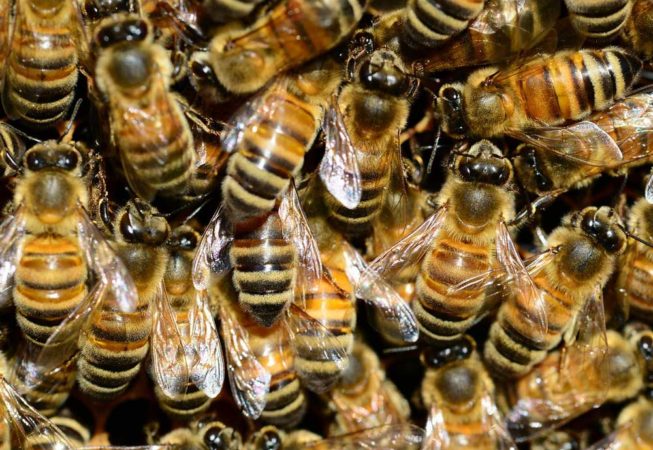Keeping Bees in February
I hope you put the hammer to Varroa and struck while the iron was hot—specifically that you took advantage of the treatment window to reduce Varroa numbers significantly during the broodless period. I think it is very important to start the year off with low Varroa mite loads—the lower the better. Randy Oliver suggests only one mite in a sample of 300 bees in the spring. That’s a very low infestation rate, equivalent to 100 mites per 30,000 bees.
If you run Randy’s Varroa growth projection model in Excel, you can understand the importance of starting the year off with low numbers. Using his default settings along with no treatments, if you start January 1 with 100 mites, then you can expect that hive to crash by mid-October. When starting with 500 mites, you can now expect that hive to crash by August 1.
It’s also much easier to manage Varroa throughout the year if you start at low levels. I can suggest three treatment options at this time of year: Apivar, HopGuard, and oxalic acid.
Apivar® (amitraz-impregnated strips): Many commercial beekeepers use this product at this time of year (particularly down in the almonds). Typically, they don’t treat again until June or July. I am told this product works best in late winter and spring. This treatment takes a total of 8 weeks for maximum efficacy, but most mites drop within the first 3 weeks.
HopGuard®: You can use this all season; it’s organically approved. It is very effective in late fall and winter with no brood in the hive.
Oxalic acid: Vapor or dribble when broodless. It has an 80–95 percent efficacy at this time.
Oregon has been getting warmer. New record highs are recorded regularly now, including this past November. Our hives were not broodless after this past Thanksgiving. Below is a temperate seasonal graph which shows approximate adult bee and brood populations throughout the year.
See: bee-health.extension.org/seasonality-of-brood-and-adult-populations-basic-bee-biology-for-beekeepers.
Because of the narrowing window for when hives are truly broodless, I’ve begun to do multiple late fall and winter treatments with oxalic vapor with no apparent deleterious effects (½ teaspoon per two deep brood boxes). In general, I apply oxalic vapor 3x about a month apart.
I monitor the mite drop 3 days after a vaporization on about 10 percent of my hives. My decision to treat again is based on mite fall. A high mite drop from a few of my hives will dictate another treatment for all of my hives. My first application this year was in early November. My highest drop was 500, followed by 200, a handful in the 100 range, the balance well below 100. Some hardly any.
You may be wondering, can we calculate an infestation rate after a treatment like oxalic vapor from mite fall? I think we can. This is how I did it for the hive that dropped 500 mites. Let’s estimate that the adult bee population in November was around 30,000 and that about 20 percent of the mites were in capped brood (I got these estimates from Ramesh Sagili and Randy Oliver concurred). Let’s also assume that oxalic vapor killed 85 percent of the phoretic mites (this is a guess). Here’s my math: Phoretic mites (1.15 x 500) = 575. Total number of mites including those in brood (575 x 1.20) = 690. This equals a 2.3 percent infestation rate (690/30,000). Not good. Fortunately for me, this hive was an outlier. Incidentally, when I treated this hive again in early December, its drop was only 86, which using the same math above represents less than 1 mite in 300 bees (anything above 90 would be greater than 1 mite/300 bees).
There may be flaws in my logic or in my estimates, but I think it is mostly right and it gives me an idea of what is acceptable and a way of checking infestation rates in the dead of winter. I will resume using Dawn Ultra (1 tablespoon per gallon of water) and Randy’s sampling cups when the weather improves.
Okay, enough about mites. What else do we need to worry about in January and February? Starvation. Heft hives for weight. Provide emergency feed like Baker’s fondant (expensive, hard to find), hard candy boards (laborious to make), or even granulated sugar over the cluster on newspaper or adjacent to the cluster in division board feeders (easy to do, no guarantee of success). Maybe you have some frames of capped honey? Place them on either side of the cluster. I see that Dadant offers winter patties that contain sugar, material called Artificial Pollen 23 (AP23®), and Honey-B-Healthy—ingredients are listed on the package. I suspect they work well. Don’t feed sugar water yet, not until the bees start flying—maybe by late February.
The following is Randy Oliver’s recipe for healthy hives:
1. Keep young, vigorous queens (he suggests replacing queens older than 18 months).
2. Provide good nutrition.
3. Control Varroa all year (we covered parts of this).
4. Minimize toxins in the hive (maybe stop using amitraz as it is not going to work eventually and we need to know how to get by without it).
5. Be proactive rather than reactive.
Todd Balsiger

